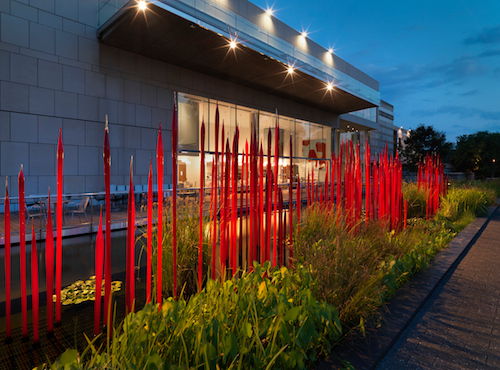Q: “The vision thing:” What is your design trying to say to the people of Virginia? What message do you hope to get across to the public?
Mather: The message is ‘Welcome.’ Public buildings should clearly say that it is exactly that, not a private club, and being a State museum, the message to the city, state and beyond is crucial. Everything about the design – building, entrances, plaza, sculpture garden – has been organized to create an invitation to enter the site. The intent is once inside, this approach is transferred to the experience of the building itself. The spaces are easily accessible. There is a clear sense of how the spaces interrelate and a continued reference to the campus and city beyond.
We sometimes refer to ‘cultural fatigue’ where it becomes too much to absorb. The exhibitions and galleries begin to seem relentless. Creating pauses and views back to interior and exterior ‘landmarks’ help avoid this and improves legibility and reduces the need for signage to find the way around. The layout becomes quickly familiar.
Often where we solve the problem areas of existing buildings – dead ends, lack of coherence for example – people can’t tell what we have done because it seems so straightforward. I find this the greatest compliment.
Q: What was the greatest difficulty you had to overcome in the design process? What particular problems does working on museums pose?
Mather: A museum project typically has a complex brief and a site with great potential and many limitations. The new building at VMFA involves a great variety of functions – exhibition – permanent and changing; administration; conservation; visitor services; kitchens; café; restaurant; library; retail; conference; and event spaces. An addition to an existing building is a huge challenge spatially and technically but in the end generates a richness to the solution. The new building had to solve previous shortcomings plus generate a sense of place internally, and for the whole museum campus. Many building materials and techniques in this project are fairly innovative – like the high performance exterior glass and low velocity air supply for example – that create a better environment and at the same time are energy efficient. Analyzing the real needs of a series of situations creates challenges but generates a better, more appropriate and sustainable building. VMFA has remained determined to achieve the benefits of this principle.
Q: In 2009, Rick Mather Architects were voted Public Building Architect of the Year in the annual Building Design awards in the UK and received the Architectural Achievement Award at the UK Design Awards. What are your most recent museum projects and why do you think you have become such a popular choice for museum clients?
Mather: Our two recent museums in the UK are The Ashmolean in Oxford and Towner in Eastbourne, on the south coast of the UK. The Ashmolean is Britain’s oldest public museum. It has a major extension as well as refurbishment and has just reopened to the public with 39 new galleries after a major expansion that provided 100% more gallery space on the original site. Our new gallery building for The Towner, Eastbourne opened in April 2009. We have also completed an addition and complete refurbishment to one of the first purpose built museums, Dulwich Picture Gallery by Sir John Soane in South London; a modern courtyard insertion and renovation project for the National Maritime Museum which is part of the World Heritage site at Maritime Greenwich; and renovation and new build spaces including a glass courtyard for The Wallace Collection in London. We are the ongoing Masterplanner for Southbank Centre, London, the UK’s National Arts Complex, which includes the Hayward Gallery, Royal Festival Hall, Queen Elizabeth Hall, Purcell Room and the British Film Institute.
I suppose you should ask our clients why they like us, but I think people generally have responded to the importance we place on legibility and clarity, the effect that carefully considered use of light and references has on the visitor, and our ability to work within existing, often historic contexts. They recognise that we see that each building we create has a responsibility to its setting. We see our buildings as ‘place making’ primarily and so the exterior spaces and relationships that our projects set up are as important as providing the uses within the building itself.
Q: This is your first major project in the US. As native of Oregon, how does it feel to be working back on home turf?
Mather: I left the US in the early 70s to do a (1 year) Urban Design course at the AA in the UK and I never came back. I found the European approach to the urban environment enlightening. The rigour of working in contexts where space was limited and so treated preciously seemed appropriate. I was appalled by the ever increasing trend towards wasted space in suburban America.
Interestingly, we were chosen to work in the US partly due to our attitude towards urbanising the site and restoring the museum to the city, and so it’s good to come back to the US where our office is recognised for what seemed to be missing here before. VMFA saw that it was paramount to place the museum firming in the city fabric and erode the ‘Fort Art’ reputation that had developed over the years since the original, civic-minded 1936 building was completed. Hopefully this represents a sea change for the better in attitudes about the sustainability of our living patterns and our faith in the city.
Q: What excited you most about the VMFA commission?
Mather: We always like to win new museum projects and we have been fortunate to work with ones which have really wonderful collections. VMFA is no exception, and particularly extraordinary when you consider the size of Richmond. Working with an institution that operates at such a sophisticated level gives the architecture a greater purpose and creates a far richer project. Having such a broad curatorial base at this very high standard only extends this further.
Q: What inspired you from the site?
Mather: Within the immediate context there are a host of historically important buildings both on the museum grounds and immediately beyond. We wanted to find a way that they would form a composition instead of being isolated elements and so the design responded quite distinctly to them in developing the relationship of building and exterior spaces.
Q: The building is mostly rectilinear on the outside but the interior, particularly in the atrium, there are many curvilinear forms which come as an unexpected but welcome surprise. What is the concept?
Mather: We certainly are pleased that there are some surprises when you enter the building. It is important for a sense of revelation to gradually unfold as you move into and then through the building. Our design process typically works from the inside out, ensuring the diagrammatic response to the brief and physical parameters work well. We then start to have some fun and allow the movement of the circulation and the space to become more animated. We start to cut away at the form to create openings for natural light to penetrate the spaces. The curves help to add a sense of place but also to tie one form in more gently to another. Vertical circulation is another area that we like to build in some drama. You will see inside the space that there are some unexpected stairs that don’t appear to have much structure holding them up, and in other places you only see the exterior forms of stairwells translated into sculptural pieces. I like to make sure that we work out carefully where to add the architectural quirks, and where to stay a bit quieter.
Q: Was there anything specific about Richmond life that developed the project in a certain way?
Mather: We recognixed that people in that area liked walking and the outdoors. The Sculpture Garden is organized so that people can pass through it as part of the experience of the general neighbourhood. The café and restaurant each have large terraces so that you can sit outside and we provided plenty of shade in both areas.
VMFA is next to the Virginia Historical Society and close to a number of other cultural buildings and so we made sure the new campus connected all of these together. One of the most well known neighbourhoods for walking – ‘The Fan District’ – leads directly to the museum and we wanted to encourage that community to keep walking through the VMFA site. The Sculpture Garden, which is free and will be open everyday to the public, has points of access on all sides to ensure that there is a strong sense of permeability. By opening a pedestrian route up to Grove Avenue at the south of the garden we could also create a strong connection towards Carytown, a thriving restaurant and shopping street, also known for walking. We have found on other projects that inviting people to move through a campus demystifies the institution, and those passers by are likely to become visitors over time.
And they seem to like parties so we made sure there was plenty of opportunity to indulge.

